The Underlying Concept Behind : "Mindfulness"
All things in life are an illusion: a phenomenon that concerns formation and disintegration with what we call time, as a factor that causes them to appear in a variety of forms when in fact they are not really there, do not exist, and are formless. Furthermore, what appears to be still, stationary and lifeless, is actually active and dynamic within itself in the same way that the earth and the solar system is in motion, revolves, flows, expands, and is changing endlessly. Thus it is the interrelationship that unites all things into one.
To look at our selves and our minds through contemplation and keep it from drifting away with our feelings is to know, not in a lethargic state, but rather by being constantly awake and alert it is like learning about life by observing the self through our senses and perception of the surroundings.
Compared to the teachings according to the words of Dhamma, this may only be a simple view based on what we are familiar with, and our instinct to relate to the world. Therefore in order to perceive right to the inner core, which is the real essence of truth, we have to concentrate on the mind. Then, we will realize that all things strive for "peace" that is not exactly the ideal one. Knowing the "self," and the striving for a balanced life of one who sees clearly, has to also include finding the point of equilibrium.
That's when we will know how to clothe ourselves modestly and not for the purpose of flaunting, have intercourse due to our reproductive instinct and not simply to satisfy our lust, eat so that we may stop eating and not so that we may live to eat.
Reaching for peace whether consciously or subconsciously therefore requires "absolute peace of mind." what has been mentioned above refers to reaching for peace at the superficial level which has yet to escape the influence of all the glamour.
It is not the strive to "cease" striving, or "nirvana" which is peace without glamour. So to observe the mind, apart from enabling to learn at the [eve[ of the relationship between the learner and what is being learnt, it is necessary to learn at the level of "emptiness."
This "emptiness" is voidness of the mind that is free from all attachments : the attachment to taking sides, to being them, being us, theirs, and ours.
When the mind is void, wisdom arises. The wise knows good from bad, right from wrong, benevolence from malevolence, or even success from failure.
He knows what is happening to his body and his mind, knows the intentions both objectively and subjectively. He knows every step that he takes, every breath, and every beat of his pulse, like knowing the hands of a clock as it moues to tell the time. He knows of every moment that takes place, with total awareness, consciousness, and "mindfulness." Thus "knowing" is knowledge of the learner and the thing that is being learnt, and cannot be separated. This is the path that would lead to peacefulness: a "state of mind" that is blissful, refreshing, calm, cool and collected - the "state of peace." Life's state of equilibrium is an important condition necessary for all of us in contemplating on adjusting our well being amidst the current of globalization.
Looking back on the works I have created in the past: "Self-Spirit of Nature" (first solo exhibition held in 1996) and "From Limestone"
(second solo exhibition held in 1998), it can be seen that these two series contain certain similarities and certain differences.
The similarities lie in the concept that links the two, concerning abstract essences in nature.
It is the contemplation on meanings derived from inner feelings that demonstrate "energy" in connection with "time" which is the determining factor.
This is the phenomenon of truth in an analogy with Buddhist philosophy. As for the differences, this can be seen in the presentation and technique used.
"From limestone" used lithographic technique with nature as a symbol of spirituality and mentality. This is like "setting the mind" on exploring the inside and outside based on a balanced interrelationship.
The presentation in two dimensions became three dimensional, mixed media, site specific installations, which was intended for the viewers to be mesmerized or move around and think as well as feel about what they see visually and psychologically.
I have pondered over and over about certain meanings that were inherent in each series of work, relying on Buddhist philosophy, by making analogies.
This revision, apart from being based on perception of truth at the moment between inside - outside, the feeling that we are all under a "state of crisis", which if we look at it deeply, will find that such state is the result of giving too much attention to one side. That is the outside, to the point of neglecting the inside - which is the "mind".
We are too preoccupied with the -illusions- and obsessed with the material world that we are led to instability and absence of peace.
According to Buddha-Dhamma, looking inwards is to see the important facts and that the "common images" are all the same.
This is to see like one who sees beyond it all and that all the meanings are therefore "the path to liberated peace of mind" in the end
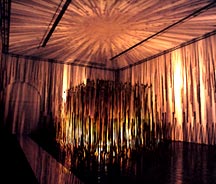 |
| “…Shed the Shells…”, 2003 Installation : shed snake skin, bamboo cane, bamboo, khon mask, welded metal, yellow light, : room dimension 8.95 x 12 x 5.40 m. (variable) >> Installation view |
 |
| Sangkarn Installation view of “ Way of Life”, 2003 : bamboo cane, yellow light (variable) |
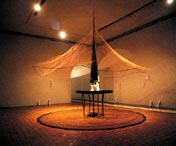 |
| “…Crisis…”, 2003 Installation : copper wire net, nylon net, copper, welded metal, plaster, water, yellow, light : room dimension 8.95 x 13 x 5.40 m. (variable) >> Installation view |
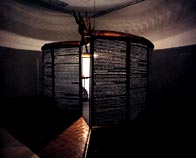 |
| “…Chapel Amidstentertainment…”, 2003 Installation : welding (iron, copper, brass) wood carving, resin,cast metal, holy strings, saffron cloth, lotus shape lamp, black cloth, silkscreen prints : size 4 m. dimension ; 2.65 m. high : room dimension 8.95 x 9.50 x 5.40 m. (variable) >> Installation view |
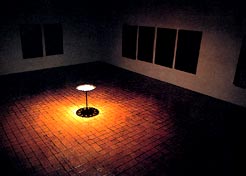 |
| “…Way of the Mind…”, 2003 Installation : cast metal with gold leaf, welded metal,drawn with pebbles-stones-acrylic on canvas, plastic boxes on the floor : size .57m. diameter; .81m. high : room dimension 8.95 x 12.75 x 5.40 m. (variable) >> Installation view |
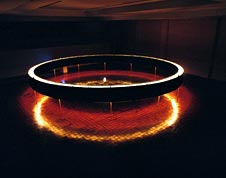 |
| “...Way of the Breath...”,2003 Installation : electrical signal patterns of heart wave from 1690 people/ages 24-99 : electrical signal patterns of heart wave “state of mind under transcendental meditation” by Supol Lohachitkul & Phatyos Buddhacharoen : silkscreen prints on carborundum paper, welded metal, yellow light, seat cushion (for meditation),wood : room dimension 18.25 x 20.85 x 4.96 m. (variable) >> Installation view |